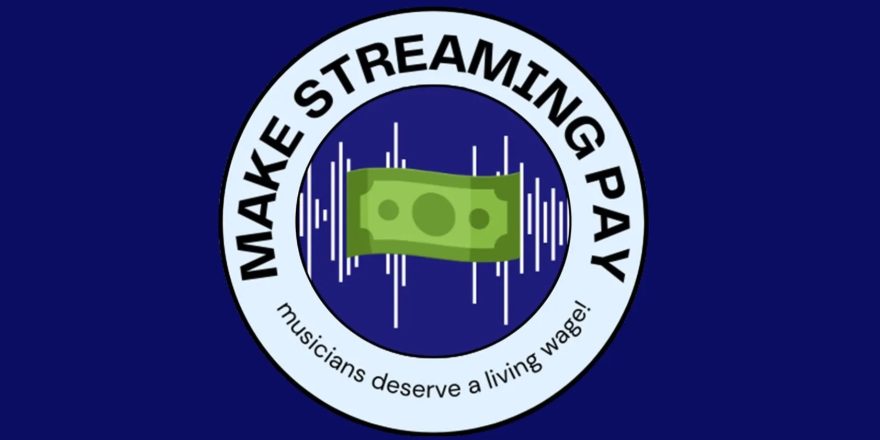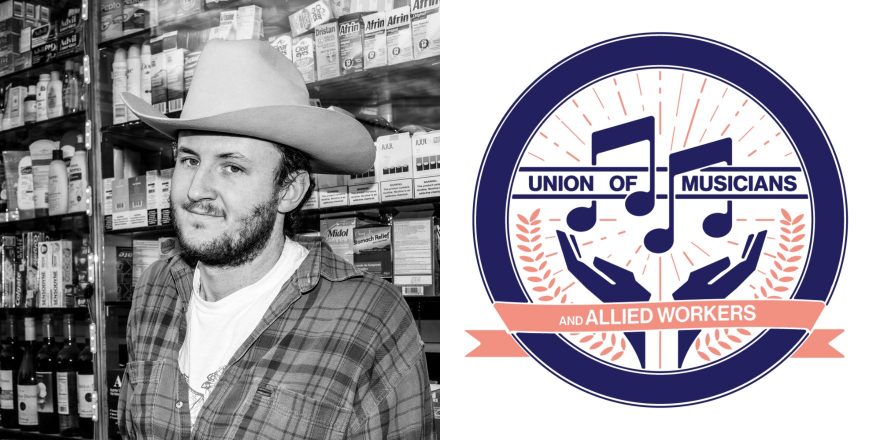“You can’t get here fast enough,” sings Meg Duffy, performing as Hand Habits on a Wednesday night in late March. They sing to a crowd that, indeed, seems to be awaiting something, something that surely can’t come fast enough: This crowd of Los Angeles musicians and fans has filled the Lodge Room in Highland Park in support of the Living Wage for Musicians Act (LWMA).
“I’m pretty broke,” says Duffy on stage, which, to an untrained eye, doesn’t make any sense. With a monthly listenership of about 150,000, Duffy earns more streams than 99.6% of all artists on Spotify. But with streaming earning an average of .003 cents per listen, and labels frequently taking a cut of as much as 80%, the truth is that even this level of success does not guarantee musicians a livable wage.
The LWMA, introduced in early March by Reps. Rashida Tlaib (D-MI) and Jamaal Bowman (D-NY), was a joint effort with the United Musicians and Allied Workers (UMAW), whose organizing work began in 2020. The Alliance has tackled crucial issues at the heart of modern musicianship, from merch cuts to fair pay at SXSW. Now, they’ve set their sights on streaming, the ultimate summit.
“The brainwashing worked and now people think music is free,” said artist James Blake in a post on X (formerly Twitter) just last month. And if the paycheck for the average musician is any indication, this is true. The pro-rata payment method employed by Spotify and other DSPs pools subscription fees and ad revenue and divies it up among artists based on the number of streams they receive. The net shakes out to an average of .003 cents per stream, and sometimes dipping even lower for smaller acts. This payout model, combined with Spotify’s slew of lawsuits against artists, makes their goal to pay musicians as little as possible crystal clear.
At the Lodge Room, though, nobody is under such delusions. “This is probably a crowd full of musicians, based on who’s on the bill,” said one of the evening’s five performers, Blake Mills, legendary songwriter and guitarist performing a stripped solo set. His final song, a percussive guitar instrumental, plays over a 2007 interview with writer Harlan Ellison. In the interview, Ellison describes a conversation with a representative at Warner Bros., which is requesting to use his writing in a DVD version of the television series Babylon 5. “Absolutely,” Ellison says, “all you gotta do is pay me. She says, ‘what?’” Mills, a true musician’s musician, continues his rapturous playing. “‘Well, it would be good publicity value,’ she says. Lady, tell that to someone a little older than you who just fell off the back of a turnip truck… The only value to me is money in my hand.”
The struggle for fair pay as an artist is a tale as old as time, but this bill sets out to tackle the most modern of parameters. “That the people who make and record the music deserve a direct payment does not seem revelatory, and yet it doesn’t exist,” said Zack Nestel-Patt, musician, organizer, and UMAW representative. With the addition of a “living wage fee” tacked onto existing subscription fees, it would create a pool of money that would circumvent labels and DSPs, going directly into the pockets of the artists themselves. Under these new parameters, artists would make a minimum of one penny per stream. This is a 300% increase from the status quo. However, there’s a ceiling on how much money an individual artist can receive. Under this bill, an artist receiving 1 million streams per track per month would earn an additional $10,000. Any additional money earned by this track, excluding standard DSP payout, would be poured back into the fund and dispersed among smaller artists.
In a scathing letter to artists, Spotify claims to be more transparent in their payout system. But what it really does is falsely justify unfair practices and insult musicians in the process, referencing large numbers of “amateurs’’ who can easily upload music onto the platform, whose livelihood does not depend upon their work as an artist. “[M]ore than 10 million uploaders have at least a single track on Spotify, but when it comes to building financial opportunities, we’re focused on those most dependent on streaming as part of their livelihood: these 225,000 emerging and professional artists that are building careers.” The sources for these numbers are fuzzy at best, and Spotify’s math feels unreliable. But it hasn’t precluded Spotify from using the figures as the foundation for major policy initiatives, such as their demonetization plan, which will stop paying artists for tracks raking in under 1,000 streams per annum.
There is no credible argument that Hand Habits is the project of an amateur, with Meg Duffy’s session musician credits and touring history stretching back over a decade. Yet Spotify’s new initiative presumes to support artists like Duffy, while in fact continuing to leave them in the dust.
Assume for a moment that these numbers are accurate — that these 225,000 Spotify-defined professionals were earning a living wage. The notion that Spotify gets to decide that labor, even part-time labor, is not only undeserving of compensation but in fact should generate free income for the Spotify C suite, is clear cut exploitation.
The Living Wage Act asks a lot from music fans. The proposed increase in streaming fees amounts to 50% of the current rate, no less than $4 and no more than $10 per monthly subscription. Like all labor issues, solidarity for musicians must extend beyond the limits of the industry itself. Such an increase in streaming fees is a small sacrifice compared to the rewards reaped by artists. For example, an artist earning 150,000 streams a month currently rakes in about $250. Under these new parameters, they’d take home almost $1800. “Many claim that such [increased] wages are not compatible with Spotify’s current economic system,” UMAW’s statement reads. “Our demand is that this model be adjusted so that artists can be paid fairly. If Spotify’s model can’t pay artists fairly, it shouldn’t exist.”
The beauty of streaming is that it encourages discovery — the flat-rate model is more profitable for the user if they listen to varied artists and genres. Without material support for the average artist — one who isn’t selling out stadiums and receiving massive label advances — the variety of music, and thus the window of discovery will narrow. Experimentation will flatline. What will the landscape look like if the megastars are the only ones making music?
So, what next? “This bill… being signed into law… is a possibility. I think that it’s a distant possibility,” said Nestel-Patt. “You can talk about the Overton window, you can talk about shifting the consciousness, but what we’re really doing is defining the parameters of the discussion and framing it from the perspective of a working class artist.” UMAW leadership encourages musicians and industry workers to join the alliance and sign the letter of support for the bill. At the show, it’s increasingly difficult to feel pessimistic while surrounded by musicians who believe in the Living Wage Act, and music fans who believe that music is still something worth shelling out a little cash for, something worth showing up for. 




